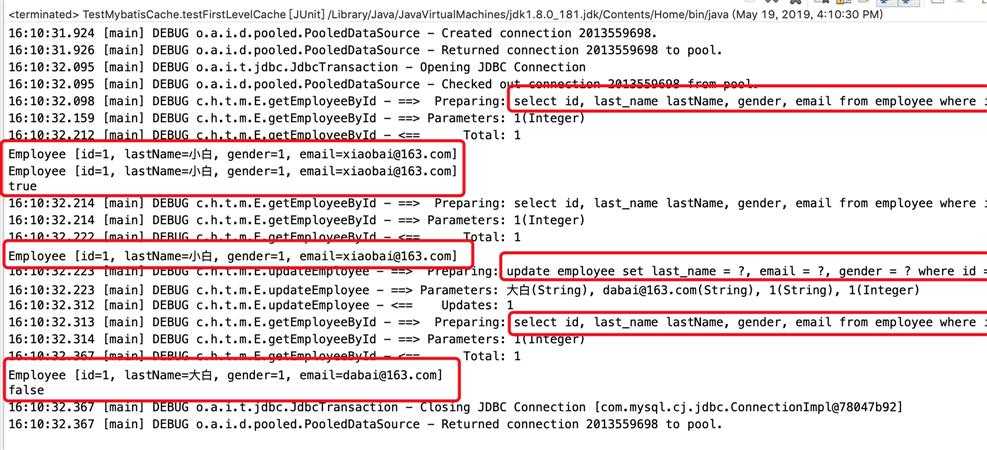标签:判断 cto 设置 垃圾回收 对象 http max 收集 moc
Mybatis 使用到了两种缓存:一级缓存(本地缓存、local cache)和二级缓存(second level cache)。
一级缓存:基于PerpetualCache 的 HashMap本地缓存,其存储作用域为 Session,当 Session flush 或 close 之后,该Session中的所有 Cache 就将清空。
二级缓存:与一级缓存其机制相同,默认也是采用 PerpetualCache,HashMap存储,不同在于其存储作用域为 Mapper(Namespace),并且可自定义存储源,如 Ehcache。
对于缓存数据更新机制,当某一个作用域(一级缓存Session/二级缓存Namespaces)的进行了 C/U/D 操作后,默认该作用域下所有 select 中的缓存将被clear。
测试代码如下:
1 /** 2 * * 一级缓存:(本地缓存):sqlSession级别的缓存。一级缓存是一直开启的;SqlSession级别的一个Map 3 * 与数据库同一次会话期间查询到的数据会放在本地缓存中。 4 * 以后如果需要获取相同的数据,直接从缓存中拿,没必要再去查询数据库; 5 * 6 * 一级缓存失效情况(没有使用到当前一级缓存的情况,效果就是,还需要再向数据库发出查询): 7 * 1、sqlSession不同。 8 * 2、sqlSession相同,查询条件不同.(当前一级缓存中还没有这个数据) 9 * 3、sqlSession相同,两次查询之间执行了增删改操作(这次增删改可能对当前数据有影响) 10 * 4、sqlSession相同,手动清除了一级缓存(缓存清空) 11 * @throws IOException 12 */ 13 @Test 14 public void testFirstLevelCache() throws IOException { 15 16 InputStream inputStream = Resources.getResourceAsStream("mybatis-config.xml"); 17 SqlSessionFactory sqlSessionFactory = new SqlSessionFactoryBuilder().build(inputStream); 18 19 SqlSession session = sqlSessionFactory.openSession(true); 20 21 try { 22 // 一级缓存查询 23 EmployeeMapper mapper = session.getMapper(EmployeeMapper.class); 24 Employee employee = mapper.getEmployeeById(1); 25 System.out.println(employee); 26 27 Employee employee2 = mapper.getEmployeeById(1); 28 System.out.println(employee2); 29 30 System.out.println(employee == employee2); 31 32 // 清除缓存 33 session.clearCache(); 34 Employee employee3 = mapper.getEmployeeById(1); 35 System.out.println(employee3); 36 37 // cud操作 38 Employee newEmploye = new Employee(1, "大白", "1", "dabai@163.com"); 39 boolean updateEmployee = mapper.updateEmployee(newEmploye); 40 Employee employee4 = mapper.getEmployeeById(1); 41 System.out.println(employee4); 42 System.out.println(employee4 == newEmploye); 43 44 } catch (Exception e) { 45 e.printStackTrace(); 46 }finally { 47 session.close(); 48 } 49 }
运行代码:

可以看到查询sql只执行了一次,并且employee与employee02是同一个对象
清除缓存后,重新执行的查询sql
cud操作后,重新执行的查询sql
1、相关配置
a、在mybatis全局配置文件中配置:
1 <!-- 设置二级缓存,默认是true --> 2 <setting name="cacheEnabled" value="true"/>
b、在EmployeeMapper.xml文件中配置
1 <cache eviction="FIFO" flushInterval="60000" readOnly="false" size="1024"></cache> 2 <!-- 3 eviction:缓存的回收策略: 4 • LRU – 最近最少使用的:移除最长时间不被使用的对象。 5 • FIFO – 先进先出:按对象进入缓存的顺序来移除它们。 6 • SOFT – 软引用:移除基于垃圾回收器状态和软引用规则的对象。 7 • WEAK – 弱引用:更积极地移除基于垃圾收集器状态和弱引用规则的对象。 8 • 默认的是 LRU。 9 flushInterval:缓存刷新间隔 10 缓存多长时间清空一次,默认不清空,设置一个毫秒值 11 readOnly:是否只读: 12 true:只读;mybatis认为所有从缓存中获取数据的操作都是只读操作,不会修改数据。 13 mybatis为了加快获取速度,直接就会将数据在缓存中的引用交给用户。不安全,速度快 14 false(默认):非只读:mybatis觉得获取的数据可能会被修改。 15 mybatis会利用序列化&反序列的技术克隆一份新的数据给你。安全,速度慢 16 size:缓存存放多少元素; 17 type="":指定自定义缓存的全类名; 18 实现Cache接口即可; 19 -->
2、测试代码如下:
1 /** 2 * * 二级缓存:(全局缓存):基于namespace级别的缓存:一个namespace对应一个二级缓存: 3 * 工作机制: 4 * 1、一个会话,查询一条数据,这个数据就会被放在当前会话的一级缓存中; 5 * 2、如果会话关闭;一级缓存中的数据会被保存到二级缓存中;新的会话查询信息,就可以参照二级缓存中的内容; 6 * 3、sqlSession===EmployeeMapper==>Employee 7 * DepartmentMapper===>Department 8 * 不同namespace查出的数据会放在自己对应的缓存中(map) 9 * 效果:数据会从二级缓存中获取 10 * 查出的数据都会被默认先放在一级缓存中。 11 * 只有会话提交或者关闭以后,一级缓存中的数据才会转移到二级缓存中 12 * 使用: 13 * 1)、开启全局二级缓存配置:<setting name="cacheEnabled" value="true"/> 14 * 2)、去mapper.xml中配置使用二级缓存: 15 * <cache></cache> 16 * 3)、POJO需要实现序列化接口 17 * 18 * 19 * @throws IOException 20 */ 21 @Test 22 public void testSecondLevelCache() throws IOException { 23 24 InputStream inputStream = Resources.getResourceAsStream("mybatis-config.xml"); 25 SqlSessionFactory sqlSessionFactory = new SqlSessionFactoryBuilder().build(inputStream); 26 27 SqlSession sqlSession = sqlSessionFactory.openSession(); 28 SqlSession sqlSession2 = sqlSessionFactory.openSession(); 29 30 EmployeeMapper mapper = sqlSession.getMapper(EmployeeMapper.class); 31 EmployeeMapper mapper2 = sqlSession2.getMapper(EmployeeMapper.class); 32 33 Employee employee01 = mapper.getEmployeeById(1); 34 System.out.println(employee01); 35 sqlSession.close(); 36 37 Employee employee02 = mapper2.getEmployeeById(1); 38 System.out.println(employee02); 39 sqlSession2.close(); 40 41 }
运行代码:

可以看到查询sql只执行了一次,并且employee01与employee02不是同一个对象
1)、cacheEnabled=true:false:关闭缓存(二级缓存关闭)(一级缓存一直可用的)
2)、每个select标签都有useCache="true":
false:不使用缓存(一级缓存依然使用,二级缓存不使用)
3)、【每个增删改标签的:flushCache="true":(一级二级都会清除)】
增删改执行完成后就会清楚缓存;
测试:flushCache="true":一级缓存就清空了;二级也会被清除;
查询标签:flushCache="false":
如果flushCache=true;每次查询之后都会清空缓存;缓存是没有被使用的;
4)、sqlSession.clearCache();只是清楚当前session的一级缓存;
5)、localCacheScope:本地缓存作用域:(一级缓存SESSION);当前会话的所有数据保存在会话缓存中;
STATEMENT:可以禁用一级缓存;
本例整合第三方缓存ehcache,文档参考:http://www.mybatis.org/ehcache-cache/
1、ehcache相关jar包
1 <!-- mybatis与ehcache缓存适配包 --> 2 <dependency> 3 <groupId>org.mybatis.caches</groupId> 4 <artifactId>mybatis-ehcache</artifactId> 5 <version>1.1.0</version> 6 </dependency> 7 8 <!-- ehcache缓存核心jar包 --> 9 <dependency> 10 <groupId>net.sf.ehcache</groupId> 11 <artifactId>ehcache-core</artifactId> 12 <version>2.6.11</version> 13 </dependency>
2、添加ehcache的配置文件ehcache.xml
1 <?xml version="1.0" encoding="UTF-8"?> 2 <ehcache xmlns:xsi="http://www.w3.org/2001/XMLSchema-instance" 3 xsi:noNamespaceSchemaLocation="../config/ehcache.xsd"> 4 <!-- 磁盘保存路径 --> 5 <diskStore path="/Users/h__d/Documents/log/ehcache" /> 6 7 <defaultCache 8 maxElementsInMemory="10000" 9 maxElementsOnDisk="10000000" 10 eternal="false" 11 overflowToDisk="true" 12 timeToIdleSeconds="120" 13 timeToLiveSeconds="120" 14 diskExpiryThreadIntervalSeconds="120" 15 memoryStoreEvictionPolicy="LRU"> 16 </defaultCache> 17 </ehcache> 18 19 <!-- 20 属性说明: 21 l diskStore:指定数据在磁盘中的存储位置。 22 l defaultCache:当借助CacheManager.add("demoCache")创建Cache时,EhCache便会采用<defalutCache/>指定的的管理策略 23 24 以下属性是必须的: 25 l maxElementsInMemory - 在内存中缓存的element的最大数目 26 l maxElementsOnDisk - 在磁盘上缓存的element的最大数目,若是0表示无穷大 27 l eternal - 设定缓存的elements是否永远不过期。如果为true,则缓存的数据始终有效,如果为false那么还要根据timeToIdleSeconds,timeToLiveSeconds判断 28 l overflowToDisk - 设定当内存缓存溢出的时候是否将过期的element缓存到磁盘上 29 30 以下属性是可选的: 31 l timeToIdleSeconds - 当缓存在EhCache中的数据前后两次访问的时间超过timeToIdleSeconds的属性取值时,这些数据便会删除,默认值是0,也就是可闲置时间无穷大 32 l timeToLiveSeconds - 缓存element的有效生命期,默认是0.,也就是element存活时间无穷大 33 diskSpoolBufferSizeMB 这个参数设置DiskStore(磁盘缓存)的缓存区大小.默认是30MB.每个Cache都应该有自己的一个缓冲区. 34 l diskPersistent - 在VM重启的时候是否启用磁盘保存EhCache中的数据,默认是false。 35 l diskExpiryThreadIntervalSeconds - 磁盘缓存的清理线程运行间隔,默认是120秒。每个120s,相应的线程会进行一次EhCache中数据的清理工作 36 l memoryStoreEvictionPolicy - 当内存缓存达到最大,有新的element加入的时候, 移除缓存中element的策略。默认是LRU(最近最少使用),可选的有LFU(最不常使用)和FIFO(先进先出) 37 -->
3、在EmployeeMapper.xml文件中配置
1 <!-- 使用ehcache作为二级缓存 --> 2 <cache type="org.mybatis.caches.ehcache.EhcacheCache"></cache>
此时运行上例中测试二级缓存方法,testSecondLevelCache,即可看到使用了ehcache。
标签:判断 cto 设置 垃圾回收 对象 http max 收集 moc
原文地址:https://www.cnblogs.com/h--d/p/10889760.html